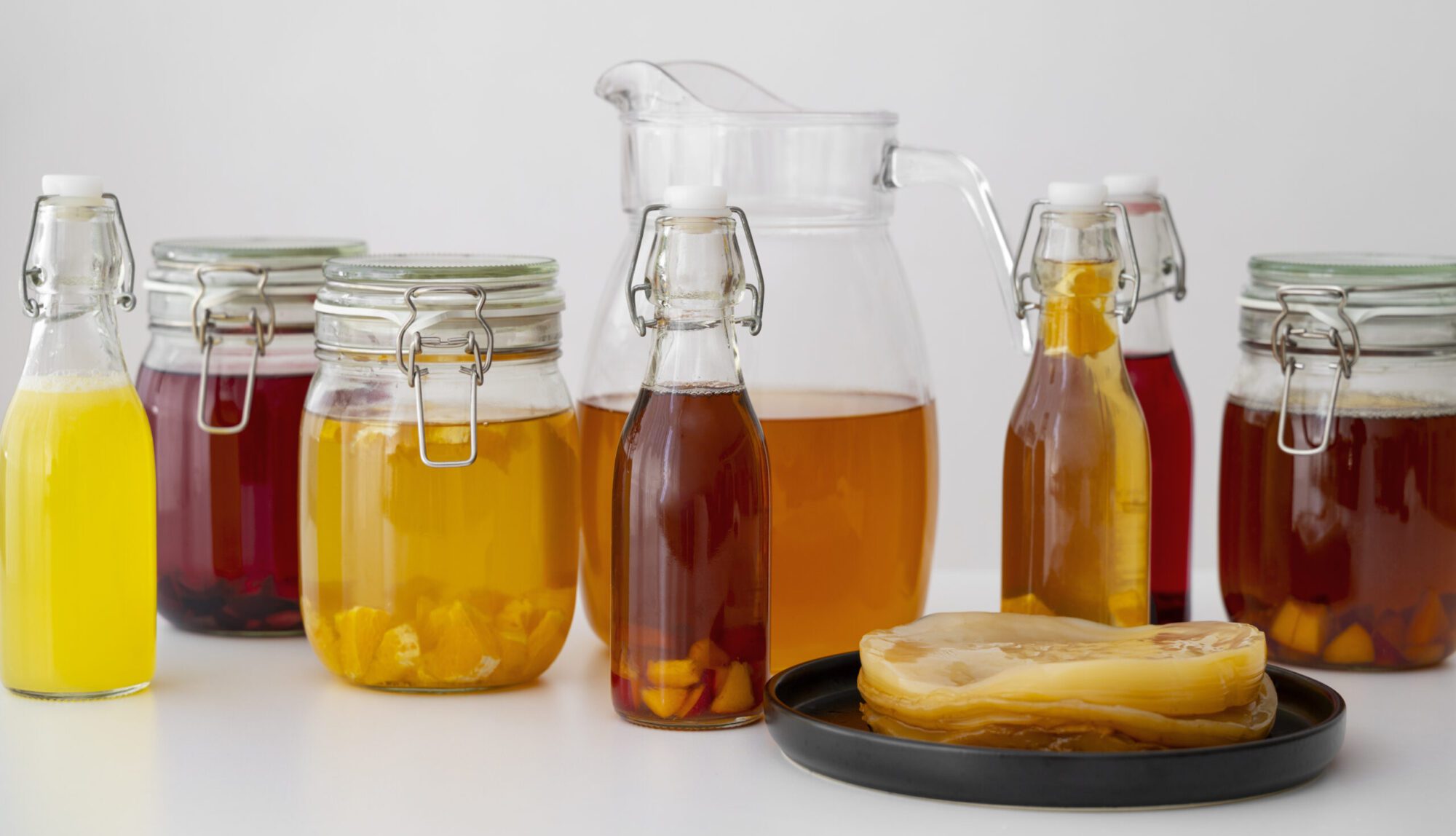Everything You Need to Know About Growing a Kombucha Scoby at Home

Everything You Need to Know About Growing a Kombucha Scoby at Home
Everything You Need to Know About Growing a Kombucha Scoby at Home
Kombucha has been gaining popularity in recent years due to its numerous health benefits and unique flavor. This fermented tea is not only a delicious beverage but also a powerhouse of probiotics, antioxidants, and beneficial acids. One of the key components of making kombucha at home is the symbiotic culture of bacteria and yeast (SCOBY), which is responsible for the fermentation process. In this article, we will explore everything you need to know about growing a Kombucha SCOBY at home, including the ingredients, equipment, and step-by-step instructions.
What is a SCOBY?
SCOBY stands for Symbiotic Culture Of Bacteria and Yeast, and it is the living organism responsible for fermenting the sweet tea to create kombucha. The SCOBY is a rubbery, pancake-like disk that forms on the surface of the kombucha as it ferments. It is often referred to as the “mother” because it is used to start new batches of kombucha and can be reused many times.
The SCOBY acquires its unique properties from the mixture of bacteria and yeast it contains. The bacteria in the SCOBY, particularly Acetobacter, convert the alcohol produced by the yeast into acetic acid, giving kombucha its slightly tangy flavor. The yeast component of the SCOBY, on the other hand, helps to create carbonation in the kombucha as it ferments.
The SCOBY also acts as a protective barrier, preventing harmful bacteria from entering the fermenting liquid and allowing beneficial bacteria to thrive. It also provides a source of cellulose, which forms a network of fibers that help to hold the SCOBY together.
Ingredients and Equipment Needed to Grow a SCOBY
Growing a SCOBY at home is a relatively simple process, and it requires only a few basic ingredients and pieces of equipment. Here’s what you’ll need:
Ingredients:
– 7 cups of filtered water
– 1/2 cup of granulated sugar
– 4 bags of black tea
– 1 cup of unflavored, store-bought kombucha (as a starter liquid)
– A small piece of mature SCOBY (optional)
Equipment:
– A large pot
– A glass jar (at least 1 gallon in size)
– A breathable cloth (such as cheesecloth or a coffee filter)
– A rubber band
– A thermometer
– A wooden spoon
– A paper towel
Step-by-Step Instructions for Growing a SCOBY
Now that you have all the ingredients and equipment ready, it’s time to start the process of growing your own SCOBY. Follow these step-by-step instructions to ensure that you create a healthy and robust SCOBY for your homemade kombucha.
Step 1: Prepare the tea mixture
Start by bringing the 7 cups of filtered water to a boil in a large pot. Once the water reaches a boil, remove it from the heat and add the 1/2 cup of granulated sugar, stirring until it is completely dissolved. Then, add the 4 tea bags and allow them to steep in the hot water for about 10-15 minutes.
Step 2: Cool the tea mixture
After the tea has finished steeping, remove the tea bags and allow the mixture to cool to room temperature. It is important to wait until the tea has completely cooled before proceeding, as hot liquid can potentially harm the live cultures in the starter kombucha and mature SCOBY.
Step 3: Add the starter liquid and mature SCOBY (optional)
Once the tea mixture has cooled, pour it into the glass jar. If you have a small piece of mature SCOBY, you can add it to the jar at this point. Otherwise, simply add the 1 cup of unflavored, store-bought kombucha as the starter liquid.
Step 4: Cover the jar with a breathable cloth
After adding the starter liquid and, if using, the mature SCOBY, cover the mouth of the jar with a breathable cloth such as cheesecloth or a coffee filter. Secure the cloth with a rubber band to keep out debris and insects while allowing airflow.
Step 5: Allow the SCOBY to grow
Place the jar in a warm, dark place where it will not be disturbed. The ideal temperature for growing a SCOBY is between 72-85°F (22-29°C). Over the next 7-14 days, a thin, gelatinous layer will form on the surface of the liquid – this is the beginning of your new SCOBY. It may take longer in cooler temperatures, so be patient and check on the progress every few days.
Step 6: Check for signs of growth
After a week or so, gently lift the cloth to check on the progress of your SCOBY. You should see a thin layer forming on the surface of the liquid. It will start off as a translucent film and gradually become opaque and white as it grows thicker. If you don’t see any signs of growth after 14 days, don’t worry – it may simply take a bit longer in cooler temperatures.
Step 7: Care for your new SCOBY
Once your new SCOBY has reached a thickness of about 1/4 inch, it is ready to be used to ferment your first batch of kombucha. At this point, you can remove the mature SCOBY from the jar, along with 1-2 cups of the kombucha liquid, and transfer them to a clean glass jar to begin fermenting your first batch. The new SCOBY will continue to grow and thicken as it ferments subsequent batches of kombucha.
Maintenance of your SCOBY
Once you have successfully grown a SCOBY, it is important to maintain it properly to ensure that it stays healthy and continues to ferment your kombucha effectively. Here are a few key tips for maintaining your SCOBY:
– Always use clean, non-toxic containers and utensils when handling your SCOBY and kombucha.
– Store your SCOBY and kombucha in a warm, dark place away from direct sunlight and drafts.
– Avoid using metal containers or utensils when handling your SCOBY, as metal can react with the acids in the kombucha and harm the live cultures.
– Avoid exposing your SCOBY to extreme temperatures or abrupt changes in temperature.
– Continuously monitor your SCOBY for signs of mold, which can indicate contamination. A healthy SCOBY will be white or off-white in color, with no visible signs of mold or unusual growths.
Using Your SCOBY to Make Kombucha
Once you have successfully grown a healthy SCOBY, you can use it to start fermenting your own batches of homemade kombucha. Here are the basic steps for making kombucha using your newly grown SCOBY:
1. Prepare the sweet tea mixture: Bring 7 cups of filtered water to a boil and dissolve 1/2 cup of granulated sugar in it. Add 4 bags of black tea and allow them to steep for 10-15 minutes. Allow the tea mixture to cool to room temperature.
2. Add the starter liquid and mature SCOBY: Pour the cooled tea mixture into a clean glass jar and add 1 cup of unflavored, store-bought kombucha as the starter liquid. Then, gently place the mature SCOBY on the surface of the liquid.
3. Cover the jar with a breathable cloth: Cover the mouth of the jar with a breathable cloth and secure it with a rubber band. Place the jar in a warm, dark place where it will not be disturbed.
4. Allow the kombucha to ferment: Let the kombucha ferment for 7-14 days, tasting it every few days to monitor the flavor. Once the kombucha has reached your desired level of tanginess, it is ready to be bottled and enjoyed.
5. Bottle and refrigerate the kombucha: Carefully remove the mature SCOBY, along with 1-2 cups of the kombucha liquid, from the jar and transfer them to a clean glass jar to start fermenting your next batch. Pour the remaining kombucha into bottles, leaving about 1-2 inches of headspace in each bottle. Seal the bottles tightly and refrigerate them to halt the fermentation process.
With these simple steps, you can enjoy delicious, homemade kombucha that is rich in probiotics and beneficial acids, and you can continue to use your SCOBY to ferment new batches of kombucha for many months to come.
In conclusion, growing a SCOBY at home is a straightforward and rewarding process that allows you to create your own homemade kombucha. From preparing the sweet tea mixture to maintaining your SCOBY and fermenting the kombucha, this guide covers everything you need to know about growing a SCOBY at home. With proper care and attention, you can have a healthy and robust SCOBY that will provide you with endless batches of delicious, fermented kombucha. Cheers to your health and happiness with your homemade brew!
[elementor-template id=”430″]
[elementor-template id=”433″]



0 Comments